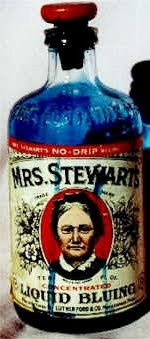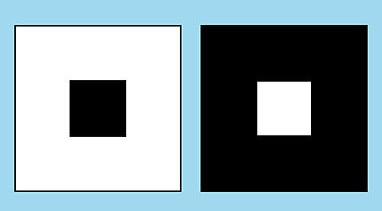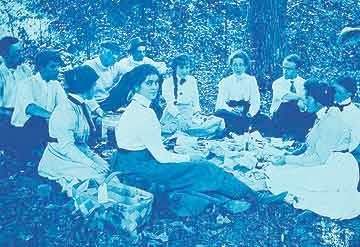Philosophy

Remember a washday product called "Mrs. Stewart's Bluing"? It was [and still is] a blue opaque liquid added to the laundry in the wash cycle to whiten "whites" and intensify light colored items. [Many powdered laundry detergents in today's market contain blue crystals of the same product and use the same concept.] It really did work. But this interesting product involves an illusion and ultraviolet light.
The illusion notion is called "irradiation" and was discovered by Helmholtz .
Look at this illustration:

The figures are identical in size, yet the white square on the right appears to be larger.
When we view an area that has both light and dark objects, the fluids in our eyes are not perfectly clear and light scatters while passing to the retina at the rear of the eye.... As a result, bright light, or light areas, spill over onto dark areas of the image that is on the retina. Thus a light region will appear slightly larger than a dark region of equal size, as in the squares shown above.
This explains why dark clothing, especially black, makes a person appear more slender than if they were wearing light or white clothing of the same design!
The "ultraviolet" part is do to the very small iron deposits [harmless] on the clothing [especially "whites"]. The invisible ultraviolet light is made visible light [via the iron particles] causing the fabric to reflect a greater proportion of light and making it appear brighter. Since the tone of the extra light reflected is on the blue side of the spectrum, this blue-violet tinge will complement any yellowing or dinginess present on the fabric to make it look whiter and brighter.
Now, you may wonder what the blue color is--the iron particles. It actually involves and little understood chemistry of the ferro/ferricyanide compounds. That chemistry was the basis for a short lived [and now somewhat revived] old photographic process called "cyanotypes"--not to be confused with the common "blueprint". The basic chemistry was the combination of potassium ferricyanide [K3Fe(CN)6 ] and an iron salt such as ferrous sulfate [FeSO47H20] that yielded a blue precipitate called "Turnbull's Blue" [iron prussate].
 Howard Pyle and his students at a summer school picnic, Chadds Ford Pennsylvania, Summer 1899.
Howard Pyle and his students at a summer school picnic, Chadds Ford Pennsylvania, Summer 1899.
Chemistry and Art: Cyanotypes and Van Dyke Prints
And Mrs. Stewart's Bluing was good for wasp and bee stings. I have no idea why.
- Dark Energy And The Nobel In Physics
The Nobel Prize for physics was announced and it goes to Saul Permutter of Berkeley, Brian Schmidt from the Australian National Observatory, and Adam Reiss from some school in Baltimore with a lacrosse team. The prize was given for the discovery that...
- End Of Laundry--no Way!
I used to own a house and some time after I sold it I was asked what I missed the most. The top five starting at the bottom: Garden, hardwood floors, woodworking area, photographic/lab, the outdoor clothesline. Air dried clothes are the best. Such a...
- Lunar Eclipse...saturday, December 10th...super-sized For Some
Dr. Tony Phillips from NASA... Waking up before sunrise can be tough to do, especially on a weekend. On Saturday, Dec. 10th, you might be glad you did. A total eclipse of the Moon will be visible in the early morning skies of western Northern America....
- A "blue Moon" On December 31st...literally
This is truly a rare occasion for on December 31st there will really be a "blue moon". "A Blue Moon For New Year's Eve" by Dave Reneke December 22nd, 2009 Moon Daily When you hear someone say "Once in a Blue Moon " you know what they mean. They're...
- False Astronomy Colors And Epistemology?
This in essence is a question of epistemology and the truth of the knowledge of what is presented to us via terrestrial and "in space" instruments that provide us photographs of objects beyond Earth. I vacillate between the Spitzer and Hubble images for...
Philosophy
"Irradiation" illusion

Remember a washday product called "Mrs. Stewart's Bluing"? It was [and still is] a blue opaque liquid added to the laundry in the wash cycle to whiten "whites" and intensify light colored items. [Many powdered laundry detergents in today's market contain blue crystals of the same product and use the same concept.] It really did work. But this interesting product involves an illusion and ultraviolet light.
The illusion notion is called "irradiation" and was discovered by Helmholtz .
Look at this illustration:

The figures are identical in size, yet the white square on the right appears to be larger.
When we view an area that has both light and dark objects, the fluids in our eyes are not perfectly clear and light scatters while passing to the retina at the rear of the eye.... As a result, bright light, or light areas, spill over onto dark areas of the image that is on the retina. Thus a light region will appear slightly larger than a dark region of equal size, as in the squares shown above.
This explains why dark clothing, especially black, makes a person appear more slender than if they were wearing light or white clothing of the same design!
The "ultraviolet" part is do to the very small iron deposits [harmless] on the clothing [especially "whites"]. The invisible ultraviolet light is made visible light [via the iron particles] causing the fabric to reflect a greater proportion of light and making it appear brighter. Since the tone of the extra light reflected is on the blue side of the spectrum, this blue-violet tinge will complement any yellowing or dinginess present on the fabric to make it look whiter and brighter.
Now, you may wonder what the blue color is--the iron particles. It actually involves and little understood chemistry of the ferro/ferricyanide compounds. That chemistry was the basis for a short lived [and now somewhat revived] old photographic process called "cyanotypes"--not to be confused with the common "blueprint". The basic chemistry was the combination of potassium ferricyanide [K3Fe(CN)6 ] and an iron salt such as ferrous sulfate [FeSO47H20] that yielded a blue precipitate called "Turnbull's Blue" [iron prussate].
 Howard Pyle and his students at a summer school picnic, Chadds Ford Pennsylvania, Summer 1899.
Howard Pyle and his students at a summer school picnic, Chadds Ford Pennsylvania, Summer 1899.Chemistry and Art: Cyanotypes and Van Dyke Prints
And Mrs. Stewart's Bluing was good for wasp and bee stings. I have no idea why.
- Dark Energy And The Nobel In Physics
The Nobel Prize for physics was announced and it goes to Saul Permutter of Berkeley, Brian Schmidt from the Australian National Observatory, and Adam Reiss from some school in Baltimore with a lacrosse team. The prize was given for the discovery that...
- End Of Laundry--no Way!
I used to own a house and some time after I sold it I was asked what I missed the most. The top five starting at the bottom: Garden, hardwood floors, woodworking area, photographic/lab, the outdoor clothesline. Air dried clothes are the best. Such a...
- Lunar Eclipse...saturday, December 10th...super-sized For Some
Dr. Tony Phillips from NASA... Waking up before sunrise can be tough to do, especially on a weekend. On Saturday, Dec. 10th, you might be glad you did. A total eclipse of the Moon will be visible in the early morning skies of western Northern America....
- A "blue Moon" On December 31st...literally
This is truly a rare occasion for on December 31st there will really be a "blue moon". "A Blue Moon For New Year's Eve" by Dave Reneke December 22nd, 2009 Moon Daily When you hear someone say "Once in a Blue Moon " you know what they mean. They're...
- False Astronomy Colors And Epistemology?
This in essence is a question of epistemology and the truth of the knowledge of what is presented to us via terrestrial and "in space" instruments that provide us photographs of objects beyond Earth. I vacillate between the Spitzer and Hubble images for...
